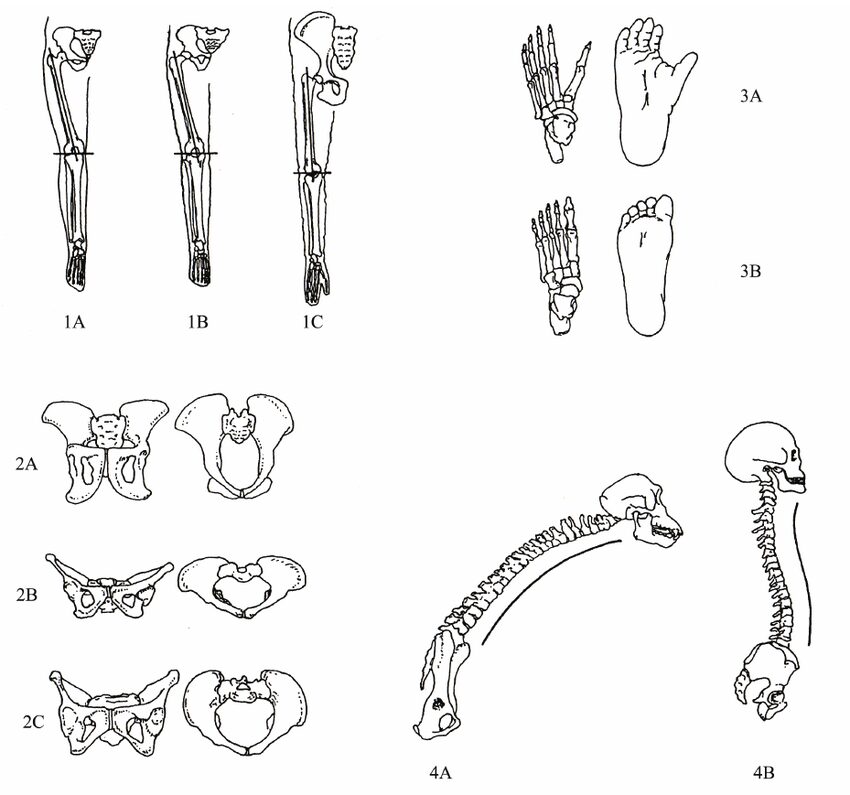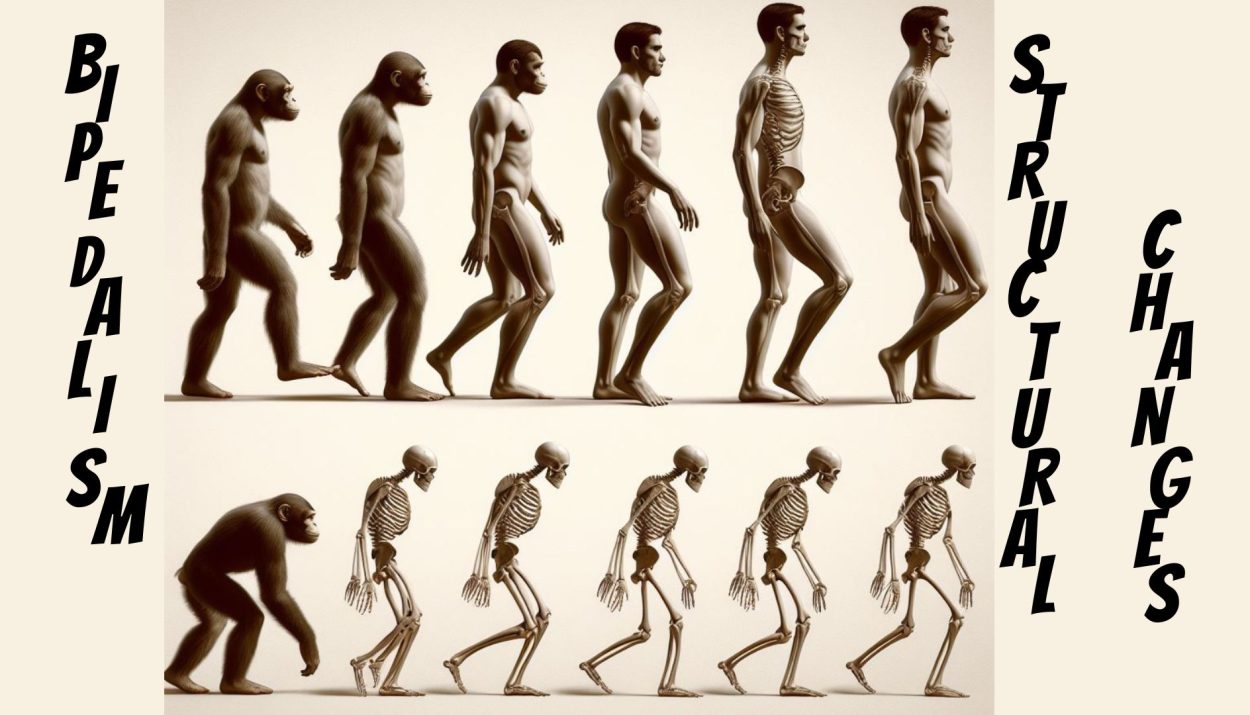Bipedal locomotion, characterized by a fully erect posture, is a distinguishing feature that sets humans apart from non-human primates. The assumption of an upright stance and walking on two legs have led to significant alterations in the human skeleton. Some notable changes resulting from these adaptations include the following:
Skull
The foramen magnum, the opening at the base of the skull through which the spinal cord passes, is positioned at the anterior base of the human skull, allowing it to be well-balanced on the Atlas, the first vertebra of the vertebral column. Consequently, the face assumes a vertical orientation. In contrast, monkeys and apes have the foramen magnum located posteriorly, leading to an imbalanced skull.
The shape of the cranial vault, or the upper part of the skull enclosing the brain, is more rounded in humans. Bipedalism is associated with a reduction in facial prognathism, meaning that the face is less protruding. To support the skull in this position, strong muscular attachments are required, resulting in a rugged nuchal region. In humans, the nuchal region is comparatively smooth due to the well-balanced placement of the foramen magnum at the skull’s base.
Vertebral column
In humans, the vertebral column exhibits four curves, specifically the cervical, thoracic, lumbar, and pelvic curves. The first and third curves are convex forward, while the remaining two are concave forward, giving the vertebral column an S-shaped configuration. These curves provide stability, absorb shock during walking, and help distribute the body’s weight evenly. In contrast, apes and monkeys have only two curves, dorsal and ventral, causing their bodies to bend forward. Additionally, noticeable changes are observed in the vertebrae. Specifically, the spines, particularly in the cervical region, are oriented downward in humans. The intervertebral discs, which provide cushioning between vertebrae, have adapted to the stresses of bipedalism. In the cervical and lumbar regions, the intervertebral discs are thicker anteriorly.
Read- Evolutionary significance of Bipedalism and Erect posture
Thorax
Alterations are evident in the thoracic region. In humans, the thorax adopts a barrel-shaped form, expanding significantly, leading to more pronounced curvature of the ribs. This shape accommodates the increased volume required for the efficient functioning of the respiratory system in bipedal individuals. The transverse diameter surpasses the dorsoventral diameter. Conversely, in apes and monkeys, the thorax presents a bulging appearance, notably tilting downward in comparison.
The scapula (shoulder blade) is positioned more laterally on the ribcage in humans. This lateral placement allows for increased freedom of movement of the upper limbs, supporting activities such as reaching and grasping while walking. The clavicles (collarbones) are shorter and more horizontally oriented in humans, providing additional stability to the shoulder girdle. This adaptation is crucial for distributing the forces associated with bipedal walking. The sternum (breastbone) is more vertically oriented, aligning with the central axis of the body. This orientation is linked to the elongation of the thoracic cavity, accommodating the expanded lungs needed for efficient bipedal respiration.

Pelvis
The habitual upright posture and bipedal walking of humans have brought about significant transformations in the pelvis, as it shoulders the weight of the head, neck, and trunk. The ilium, one of the three bones forming the pelvis, has become shorter and broader. This adaptation provides a stable platform for the weight of the upper body, especially during the upright stance. The iliac bone has evolved into a fan-shaped structure, aiding in the redistribution of forces and providing support for the body’s centre of gravity over the hips. The angle formed by the ilium and ischium is smaller in humans.
The acetabulum, the socket where the femur articulates with the pelvis, has shifted more towards the front (anterior) of the pelvis. This relocation optimizes the transmission of forces during weight-bearing activities. The sacrum, a triangular bone at the base of the spine, exhibits a curvature that helps support the vertebral column and facilitates a balanced distribution of weight over the pelvic girdle. The sacrum exhibits a shorter length, increased width, greater ventral concavity, and anterior rotation in comparison to apes. The ischial tuberosities, the bony prominences that support body weight while sitting, are more prominent and enlarged in humans compared to non-bipedal primates.
Bipedalism has led to an increase in the transverse diameter of the pelvis. This widening helps in balancing the body over the legs and supports the pelvic organs. The birth canal, through which the baby passes during childbirth, is wider and more circular in humans. This adaptation is crucial for accommodating the bipedal reproductive process.
Femur
The femur is a crucial connection between the pelvis, vertebral column, and lower legs in bipeds. Unlike apes, whose femurs are vertical, humans possess femurs that exhibit a slight medial angle from the hip to the knee. This configuration brings human knees closer and positions them under the body’s centre of gravity. This adaptation allows humans to lock their knees and maintain an upright posture for extended periods without excessive muscular effort.
The femur provides support to the pelvis from below by connecting its head to the acetabulum, which is oriented downward and outward. Remarkable changes in the femur include the development of a distinct linea aspera, a well-defined popliteal area, a larger angle formed by the axis of the shaft and that of the head and neck, and a medial condyle of considerable size extending well below the level of the lateral condyle.
Foot
The development of a longitudinal arch in the foot helps absorb shock and distribute body weight evenly during walking. This arch structure is absent or less pronounced in non-bipedal species. The big toe, or hallux, is aligned parallel to the other toes and is more robust in humans. This alignment enhances balance and provides a strong push-off during walking. Compared to non-bipedal primates, human toes are generally shorter and less prehensile.
The heel bone, or calcaneus, is robust and adapted to withstand the increased load from walking upright. This is in contrast to the more elongated and flexible heel in non-bipedal primates. The arches of the foot are flexible, allowing for efficient energy transfer and shock absorption. This adaptability is crucial for accommodating variations in terrain during walking. Bipedalism has influenced the development of muscles and tendons in the foot, such as the strengthening of the plantar fascia and the Achilles tendon, to support the demands of walking and running on two legs.
References
Book- Physical Anthropology and Human Genetics by B.R.K. Shukla and Sudha Rastogi
Book- Outline of Physical Anthropology by B.M. Das
Farris DJ, Kelly LA, Cresswell AG, Lichtwark GA. The functional importance of human foot muscles for bipedal locomotion. Proc Natl Acad Sci USA. 2019 Jan 29;116(5):1645-1650. doi: 10.1073/pnas.1812820116. Epub 2019 Jan 17. PMID: 30655349; PMCID: PMC6358692. https://www.ncbi.nlm.nih.gov/pmc/articles/PMC6358692/
Gruss Laura Tobias and Schmitt Daniel 2015 The Evolution of the human pelvis: changing adaptations to bipedalism, obstetrics and thermoregulationPhil. Trans. R. Soc. B370:20140063.20140063. https://royalsocietypublishing.org/doi/10.1098/rstb.2014.0063
Walking on two legs – bipedalism
Human skeletal changes due to bipedalism- Wikipedia
Gruss LT, Schmitt D. The evolution of the human pelvis: changing adaptations to bipedalism, obstetrics and thermoregulation. Philos Trans R Soc Lond B Biol Sci. 2015 Mar 5;370(1663):20140063. doi: 10.1098/rstb.2014.0063. PMID: 25602067; PMCID: PMC4305164. https://www.ncbi.nlm.nih.gov/pmc/articles/PMC4305164/
Crompton RH, Günther M. Humans and other bipeds: the evolution of bipedality. J Anat. 2004 May;204(5):317–9. doi: 10.1111/j.0021-8782.2004.00299.x. PMCID: PMC1571307. https://www.ncbi.nlm.nih.gov/pmc/articles/PMC1571307/
Bipedalism, birth and brain evolution- The Guardian







